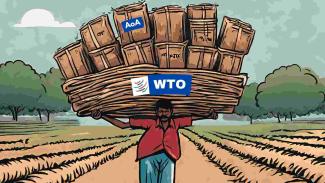Today, the tractor, a vital tool for the farmer, has become an anti-national vehicle. Police in Haryana and Delhi are making every effort to stop farmers on tractors from entering Delhi. These very tractors and farmers’ toil are responsible for our daily food, vegetables, and fruits. However, when the time came for listening to the grievances of farmers, the Modi regime greeted them with violence and repression.
Farmers' demand is to make Modi government fulfil its assurance of making Minimum Support Price (MSP) a legal right. Following farmers protests, the three farm laws which Modi government introduced in 2020 and later revoked, one of the promises that was made was to legalise MSP. Farmers argue, the way every product in market has a maximum retail price (MRP), why cannot crop produced by farmers have an MSP? Currently, the Government of India announces MSPs for 23 crops and declaration of MSP does not mean, government is going to procure for surety.
Then why can’t Modi government ensure MSP for all crops and legalise the same for ensuring private players? The answer lies in the Agreement on Agriculture and the World Trade Organisation.
The Agreement on Agriculture (AoA) introduced in World Trade Organisation (WTO) in 1995 prohibits subsidies and duties on the pretext that they distorts the market. AoA-WTO came with the process of globalization that introduced measures of Liberalisation and Privatisation across the world. The idea behind the subsidy reduction was to open the markets of all nations to products produced in other countries.
When the negotiations started for the AoA, India, like other developing countries, despite knowing the consequences of acceding to the trade regime, willingly went ahead and made farmers suffer the consequences of it. India's position during this negotiation broadly spoke about protecting the farmers and alleviating the poverty. But, however, the developed countries started off with a greater buffer level. Not only were they economically well-placed, but also they were politically strong.
There was reluctance from developed countries to make any concessions regarding their agriculture sector because it was one of the highly protected markets. This is an irony as it is the same countries who preach about protective measures to be dismantled in developing countries.
Now, it is in this context that we have to understand the reduction of state support in Agriculture.
In the early 90s, the developed countries had the financial wherewithal to sustain reduction of state support in one kind of subsidy, to replace them with another kind of subsidy [non-distorting as per WTO]. For example, in the case of de-coupled direct income support for farmers and other measures that became part of the green box (no restriction in subsidy limit; see Figure 1) meant that developed countries could comfortably withdraw themselves from trade distorting market mechanisms in the domestic market like minimum support price, universal subsidies. In comparison to the developing countries, they had less number of farmers and people depending on the farming sector.
Understanding this becomes essential in how our agriculture economy suffered the most when the government withdrew from most of the state-support it provided – fertilizer, pesticide, infrastructure for irrigation, procuring from farmers, providing minimum support price, and so on. This situation meant that the vulnerable farmers in India were competing with large-scale farms from developed country.
Realising the cost that India has paid for getting integrated into the WTO, and the rising farmer suicides, India along with other developed countries in late 2000s, were arguing for greater ability for food security programmes. The National Food Security Act, 2013 in India was a product of this realization.
However, this meant India had to breach the 10% de-minimis [minimal amounts of domestic support that are allowed even though they distort trade] subsidy regime for public procurement. This resulted in India and other developing countries negotiating for a permanent “peace clause” in WTO for food security programmes. This means any WTO member cannot challenge or claim damages if countries like India breach its subsidy limit for public food procurement for the food security programme.
In 2013, coming under the pressure of developing countries, the developed countries agreed to a temporary “peace clause”. However, the final text remained ambiguous. This meant that many developed countries who were not happy with India’s subsidy regime and food security programme started raising questions in the WTO, leading to a situation where the peace clause became ineffective.
India and other developing countries are negotiating to get a permanent peace clause notified. On the other hand, the developed countries are doing everything in their capacity to stall the process and deny developing countries the policy to protect their farmers and people.
Having lost the state support, facing increased input prices and falling market prices for products, the farmers are facing severe losses and indebtedness.
The clause of trade distorting and non-distorting subsidies in AoA is the product of global attempt by multinational corporations to capture the agricultural sector in Third World countries in the name of globalisation. Today, the majority of farmers in the developing world and also, from the developed countries are under constant threat due to the push by neoliberal forces to turn the tillers into corporate slaves. This, corporatization of agriculture, is the very basis for the ongoing destruction of state support for farming, which has resulted in a lack of food security and livelihood for millions of people across the globe.









